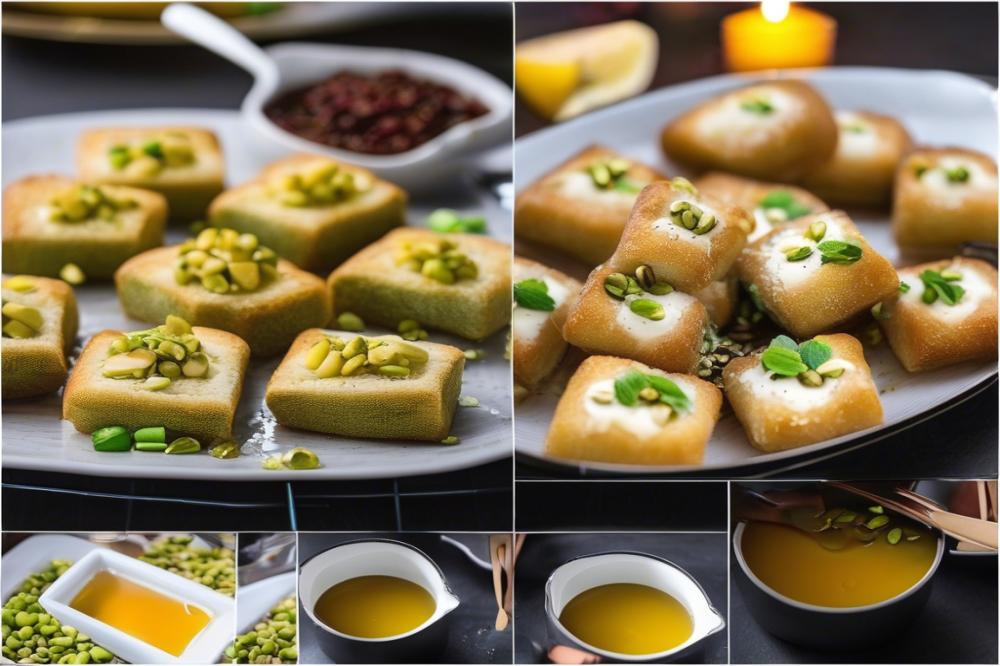Introduction
Halawet El Jibn is a delightful type of sweet cheese roll that embodies the rich culinary heritage of Egypt and the broader Middle Eastern region. This dessert is made primarily from cheese and semolina, creating a unique texture that is both chewy and creamy. Often filled with nuts or drizzled with syrup, these cheese pastries offer a satisfying experience for anyone who indulges.
The significance of such dessert lies in its representation of diverse food culture. Egyptian sweets often celebrate communal gatherings, family occasions, and various festivities. The preparation of these sweet treats is more than just a culinary task; it involves traditions that have been passed down through generations. Each bite transports one to a world where every ingredient tells a story of rich heritage and craftsmanship.
In this article, we will explore the steps involved in making authentic Halawet El Jibn. Readers will learn about traditional recipes and the culinary techniques that enhance the flavor of these sweet cheese rolls. The aim is to provide clarity on dessert preparation, ensuring that anyone can replicate this delightful Egyptian dessert at home. With this knowledge, the warm flavors of Middle Eastern desserts can be enjoyed by everyone.
Understanding Halawet El Jibn

Halawet El Jibn is a traditional Egyptian dessert known for its delightful combination of flavors and textures. This dish features sweet cheese rolls that are often filled with a variety of fillings, such as cream or nuts. It stands out due to its soft, chewy texture and the rich sweetness that comes from sugar syrup and coconut flakes. The creation of these cheese pastries requires specific culinary techniques, making it a unique addition to Egypt’s vibrant food culture.
The origins of Halawet El Jibn can be traced back to the rich history of Egyptian cuisine. It reflects influences from both local ingredients and the broader Middle Eastern culinary tradition. Often enjoyed during special occasions and gatherings, this dessert showcases the artistry involved in Egyptian dessert preparation. Generations have handed down traditional recipes, keeping the practice alive and evolving.
When compared to other Middle Eastern desserts, Halawet El Jibn holds a special place. Many desserts in this region include nuts, syrups, and phyllo dough, but the use of cheese sets this treat apart. While baklava and kunafa are also highly appreciated, the sweetness of cheese in this roll creates a distinct flavor profile. Chocolate and vanilla often feature in desserts, but they rarely combine with cheese as they do in this case.
The significance of cheese in Egyptian sweets cannot be overstated. Cheese is a staple ingredient that adds depth and richness to many dishes, including desserts. This ingredient allows for a delightful contrast between flavors. Using cheese in sweet treats contributes to a cultural appreciation. Its presence reveals the delicious versatility that can satisfy varied palates throughout Egypt and beyond.
Ingredients for Halawet El Jibn

This classic Egyptian sweet cheese rolls recipe contains a few key ingredients that blend together to create a delightful dessert. Let’s take a closer look at what you will need for this traditional dish:
- 2 cups mozzarella cheese
- 1 cup semolina
- 1/2 cup sugar
- 1/3 cup water
- 1 tsp vanilla extract
- 1/4 cup unsalted butter
- 1/2 cup corn flour
- 1 cup sugar syrup (for drenching)
- Chopped pistachios for garnish
Nutritional Information of Each Ingredient
The mozzarella cheese serves as the primary ingredient. Rich in protein and calcium, it offers essential nutrients beneficial for bone health. Semolina is made from durum wheat, providing carbohydrates and vitamins, supporting energy needs.
Sugar contributes sweetness, but it also adds calories without any essential nutrients. Water, being calorie-free, plays an important role in the mixture, helping to blend the dry ingredients. Vanilla extract not only enhances flavor but also brings its own trace nutrients to the mix.
Unsalted butter adds richness and depth to flavor. It contains fats which are important for energy, although moderation is key. Corn flour, gluten-free and low in protein, thickens the mixture, contributing to texture.
Finally, sugar syrup is necessary for drenching the sweet cheese rolls, adding sweetness and moisture. This syrup, while delicious, is high in sugar as well. Chopped pistachios garnish the dish, adding crunch and healthy fats along with a dose of protein.
Preparing these ingredients with care showcases traditional recipes and reflects the food culture of Egypt. Combine them using proper culinary techniques, and you’ll create exquisite cheese pastries that delight many. Indulging in such sweet treats connects people to Middle Eastern desserts and their history.
Method of Preparation

Step-by-step cooking instructions
To begin making the sweet cheese rolls, first gather your ingredients. For the cheese mixture, take a suitable amount of white cheese, such as mozzarella or ricotta. Shred or crumble the cheese into a bowl. Add a bit of sugar for sweetness and a splash of warm milk. Mix everything until the texture becomes smooth and creamy. This will be the filling for your rolls.
Next, moving on to cooking the semolina. Take a pot and add semolina along with some water and a bit of butter. Stir this over medium heat until the mixture thickens. It should have a dough-like consistency when done. Allow it to cool slightly after cooking. Once cool enough to handle, mold the mixture into flat rectangles on a clean surface, resembling small sheets.
Now it’s time for filling and rolling. Spoon the cheese mixture onto each semolina rectangle. Carefully fold the sides over the filling, then roll it up tightly. Make sure it remains sealed to avoid any spillage during the cooking process. Place each roll seam-side down on a baking dish. This will help maintain the shape as they cook.
Serving suggestions with sugar syrup and garnishing
After the rolls have been assembled, cooking them comes next. You can either bake or steam them for a softer texture. Once cooked, drizzle with a generous amount of sugar syrup. This adds a delightful sweetness and a shiny glaze. For garnishing, sprinkle some crushed pistachios or shredded coconut on top. Such toppings enhance both flavor and visual appeal.
Tips for achieving the perfect texture and flavor
Achieving the right texture is crucial in making these Egyptian sweets. Be sure to cook the semolina patiently; hurried cooking can lead to a grainy texture. Also, adjust the sugar according to taste. Not everyone enjoys the same level of sweetness. Experiment with flavors by adding a hint of rose water or orange blossom for a unique twist. This can elevate the dish considerably, adding depth to the sweet treats.
Common mistakes to avoid in dessert preparation
While preparing these cheese pastries, several common mistakes can arise. Skipping the cooling step after cooking the semolina can make the dough hard to handle. It’s essential to let it cool before rolling. Overfilling the rolls is another frequent error. This may lead to messy results or bursting while cooking. Finally, and importantly, do not rush through the process. Each step requires attention to detail, ensuring the final product reflects the authentic culinary techniques of Egyptian desserts.
The Cultural Context of Halawet El Jibn

In Egyptian food culture, Halawet El Jibn occupies a special place. These sweet cheese rolls represent more than just dessert; they symbolize hospitality and tradition. Families often share these delightful treats during festive gatherings and celebrations. Birthdays, weddings, and religious holidays commonly feature this beloved dish. Its presence at such events highlights its importance in social interactions.
The recipe for this dessert has evolved over the years. Traditional recipes have undergone modifications influenced by modern culinary techniques. While some still prefer the classic method, many now explore creative variations. New ingredients may enhance flavors and textures, enriching the culinary landscape of Egyptian sweets. This adaptability keeps the dish relevant while preserving its heritage.
Halawet El Jibn also impacts contemporary Middle Eastern desserts. Its cheese pastries inspire chefs across the region. Many dessert preparations draw from this classic treat, showcasing its versatility. Chefs experiment with fillings and toppings, creating innovative sweet treats that captivate diners. As a result, it bridges the old and the new within the realm of dessert-making.
Sharing Halawet El Jibn is an act of generosity. Friends and family often come together to enjoy these treats, fostering connections. This dessert continuously plays a role in shaping the social fabric of Egyptian communities. Its production and consumption are part of a larger narrative in the culture of food.
Final Thoughts on Mastering Egyptian Sweets
Mastering the art of preparing Halawet El Jibn is a rewarding experience. This dessert holds a cherished place in Egyptian culture and brings joy to many occasions. Learning how to make these sweet cheese rolls not only connects you to a rich culinary tradition but also allows you to share something special with others.
Encouragement to try making this delicious treat comes easily. The process may seem challenging at first, but practice makes perfect. Each attempt yields improvements and more authentic results. Experimenting with flavors can make it a fun adventure in the kitchen. Everyone loves a homemade dessert, especially one steeped in history.
In closing, authentic Halawet El Jibn showcases the beauty of Egyptian sweets. Each roll embodies a blend of simplicity and creativity, making it an art form. As you embark on this culinary journey, take pride in your efforts. Sharing these delightful flavors brings people together and creates lasting memories. Start experimenting, and enjoy the sweet rewards of your hard work!



